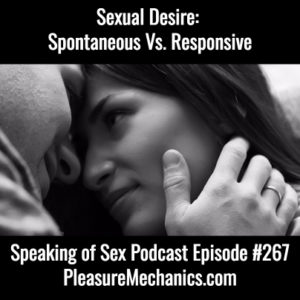
Do you know the difference between spontaneous desire and responsive desire? How do these two types of desire show up for men vs. women? And why do the two types of desire matter in how you think about your own sexual desire, libido and sex drive?
In this episode we dive deep into the two types of desire and why desire is not a simple matter of wanting good sex more often.
Desire is a tricky word. Our cultural scripts of sexual desire leave a lot of people feeling like there is something wrong with them.
Do I have too much sexual desire? Not enough? Is what I desire normal? Are my desires too boring? What if I desire someone who is not my partner?
Desire can be a terrain so fraught with judgement and shame, it sometimes almost feels safer to desire nothing at all.
Men are taught that they should be thinking about sex constantly (every 7 seconds?) and always be ready and in the mood for sex. Anything less than constant horniness is considered insufficient.
Women are taught they need to be scared of their own sexuality, wary of men’s constant desire, and vigilant to protect their virtue. Many women believe that their sexual desire only blossoms in response to a man’s interest, and don’t seek out independent sources of erotic pleasure. If a woman feels too much desire, she is a cheap slut. If she feels too little, she is a frigid prude.
And yet, between these two opposite experiences of desire, when the chemistry is just right, couples are supposed to feel the perfect harmony of their desire and their libidos should come together in a regular rhythm of desire.
These cultural scripts leave many people feeling broken. Against these mythical standards of desire, most people feel like they have some desire disorder that needs to be fixed. Couples stress about mismatched libidos and desire discordance. It is a great trick of sex negative culture to create a standard that no one can fit into, and then make each individual feel shamed and broken.
We can do better. We need a cultural conversation about desire that matches how sexual desire is actually felt and experienced in our everyday lives – with the recognition that what is “normal” is a vast variety of experiences that fluctuates wildly depending on too many factors to name.
How often do you feel sexual desire out of the blue? For most people, the sudden feeling of being horny happens pretty rarely. Yet this experience of “spontaneous” desire is held up as a gold standard of being a virile sexual being, especially for men.
Sometimes, sexual desire rises out of an internal thought. A memory of a sexy encounter or a private fantasy can trigger a cascade of desire and longing.
Sometimes, sexual desire rises out of an external trigger. Seeing an attractive person, feeling a nice sensation, even a great song can create sexual desire to rise in the body. Sometimes, emotional intimacy with an interesting person can trigger waves of desire that carry you for days.
But for many people, sexual desire doesn’t start rising until they are already in the midst of an erotic act. This is “responsive desire” and is an entire category of desire that is not honored and harnessed to it’s full power. Responsive desire happens when you are willing to receive pleasurable stimulation, from a safe source, and let that pleasure trigger the excitement for more pleasure.
This episode is sponsored by Good Clean Love and their line of organic personal lubricants and sexual wellness products. Explore the complete line at GoodCleanLove.com and use the code PLEASURE for 33% off your entire order!
The post Sexual Desire: Spontaneous Vs. Responsive appeared first on Pleasure Mechanics.